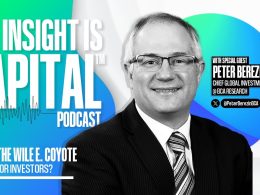Are Corporate Bonds Expensive?
November 2012 – Investment Strategy Group
As in the case of Treasury bonds, yields for U.S. corporate credits have fallen to historic lows as prices have risen. The yield on the Barclays Aggregate U.S. Investment Grade Bond Index was recently at 2.8% –far below levels achieved during the heady days of 2007. Obviously, this reflects overall interest rates, but is it also a sign that corporate issues may be overvalued? We explore the issues and consider how investors should position their portfolios for the current environment.
Policy-Driven Yields Decline
Currently low corporate bond yields are largely a function of the decline in U.S. Treasury rates, prompted by the Federal Reserve’s loose monetary policy. Comparing current corporate bond yields to levels in 2007 (a time when the economy still registered growth above 3% and the Federal Reserve maintained interest rates above 5%) the interest rate component of corporate bond yields has declined from 65% to 25% for high yield bonds and from 85% to 50% for investment grade corporate bonds.
By definition, this means that corporate bond yields are now compensating investors more, proportionally, for credit risk (or the possibility of default) than before. A better way to assess their valuations, however, is by looking at whether yield spreads (the difference between their yields and those of Treasuries) appropriately reflect expectations of defaults.
Investment Grade Bonds
As of November 15, spreads for investment grade bonds were trading at around 150 basis points (bps), higher than the historical average of around 130 bps and significantly higher than pre-crisis lows of 76 bps in February 2007. By this measure, investment grade corporate bonds continue to look attractive as defaults remain low. Despite the fact that some credit metrics such as revenue and earnings growth appear to have marginally weakened in the third quarter, corporate balance sheets remain robust with high cash balances and strong interest coverage ratios. This is a result of prudent fiscal management by many companies in the past few years as macroeconomic concerns persisted. Given the strength of their balance sheets, we expect corporate bonds generally to be fairly resilient, even if the global economy slides into a deeper slump.
But the low yields have resulted in the emergence of a new risk. As corporations take advantage of cheap financing by issuing lower yielding and longer maturity securities, their bonds’ sensitivity to changes in interest rates (i.e., duration) has been rising steadily. Currently, the average duration of the Barclays Aggregate Investment Grade Bond Index is at around 7.2 years (see display), up from around 6.0 in 2002. This means that every percentage increase in Treasury rates will induce increasing losses in the index. While interest rates are likely to stay low in the near term, unexpected rises in economic growth or inflation could cause rates to reverse rapidly and have a potentially large negative impact on investment grade bonds even if defaults remain low.
INVESTMENT GRADE BONDS’ RISING SENSITIVITY TO INTEREST RATES
Source: Barclays Capital, ISG (Data through November 1, 2012)
High Yield Bonds
Like the investment grade market, high yield bonds have also had a very good run since the economic recovery began in 2009. This year, the high yield market has returned approximately 13% (through October 31), making it one of the best performing asset classes. Unlike investment grade bonds, however, spread historically accounts for the bulk of the yield on below-investment grade bonds. Still, the current spread of 579 bps (as of November 15) is elevated, indicating that investors continue to assign a significant risk premium to the asset class. In our view, this risk is overstated as default rates remain below their historical average (see display below). At these default rates, yields have historically traded closer to 400 bps.
COMPENSATION FOR DEFAULTS IN HIGH YIELD BONDS IS STILL HIGH
Source: Moody’s Investors Services, FactSet, ISG (Data through September 30, 2012)
It is reasonable for investors to wonder whether low yields might prompt corporates to leverage up, which could conceivably lead to deteriorating credit quality. However, the reality is that much of the recent issuance has been used for refinancing as corporations take advantage of the low rates. This actually has the effect of pushing out the timeline in which the bonds’ principals are repaid, which lowers default probabilities in the near term. In addition, the corporate leveraging cycle also generally takes years to build up and we see little sign of excessive practices so far in this roughly $1 trillion asset class.
Still, investors need to be aware that while valuation and fundamentals continue to look favorable, high yield bonds are sensitive to changes in investor sentiment. A deteriorating outlook, precipitated by nervousness around the fiscal cliff, might cause spreads to widen even if defaults do not rise. Moreover, high yield bonds are generally more volatile than traditional fixed income securities.
Asset Allocation
From an asset allocation point of view, we remain relatively positive on high yield bonds due to strong fundamentals and spreads that are above the historical average, but we are less sanguine on investment grade bonds due to their low yield and increasing sensitivity to Treasury rates. Should growth remain steady and Fed policies accommodative, both high yield and investment grade spreads should compress further. But at lower yields, returns are likely to be less impressive than the past few years.
Another important factor is the level of Treasury yields. In the recent past, declines have provided a tailwind for corporate bonds, but that could be reversed if growth accelerates or inflation begins to make a comeback. This does not necessarily mean investors should radically reduce corporate bond holdings; in fact our Asset Allocation Committee favors a reduced allocation to Treasuries instead. In addition, the Committee currently prefers securities such as bank loans, Master Limited Partnerships (MLPs) and Real Estate Investment Trusts (REITs) for income generation as they tend to be less sensitive to rising interest rates.












